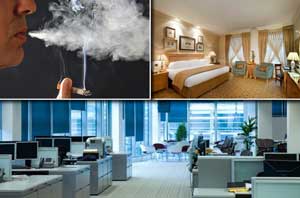
Offices | Corporate
Hotels | Resorts | Bar | Restaurants
Hospital | Gym | Health Care
Theaters | Malls | Conference Hall
Airport | Metros | Railways
Schools | University | Colleges
All of us face a variety of risks to our health as we go about our day-to-day lives be it Driving in cars, flying in planes, engaging in recreational activities. The most recent are commercial buildings, multiplexes, shopping malls etc and being exposed to environmental pollutants all pose varying degrees of risk. Some risks are simply unavoidable, some we choose to accept because to do otherwise would mean restricting our ability to lead our lives the way we want & some risks we might decide to avoid if we had the opportunity to make informed choices. Indoor air pollution is one risk that you can do something about.
In the last several years, a growing body of scientific evidence has indicated that the air within homes, offices, shopping malls and other buildings can be more seriously polluted than the outdoor air even the largest and most industrialized cities. Other research indicates that people spend approximately 90 percent of their time indoors. Thus, for many people, the risks to health may be greater due to exposure to air pollution indoors than outdoors.
In addition, people who may be exposed to indoor air pollutants for the longest periods of time are often those most susceptible to the effects of indoor air pollution. Such groups include the young, the elderly, and the chronically ill, especially those suffering from respiratory or cardiovascular disease.
What Causes Indoor Air Pollution?
Indoor pollution sources that release gases or particles into the
air are the primary cause of indoor air quality problems. Inadequate
ventilation can increase indoor air pollutant levels by not bringing
in enough outdoor air to dilute emissions from indoor sources and by
not carrying indoor air pollutants out of the home. High temperature
and humidity levels can also increase concentrations of some
pollutants.
There are many sources of indoor air pollution in any building. These include combustion sources such as oil, gas, kerosene, coal, wood, and tobacco products; building materials and furnishings as diverse as deteriorated, asbestos-containing insulation, wet or damp carpet, and cabinetry or furniture made of certain pressed wood products; products used for cleaning and maintenance, personal care or hobbies; central heating and cooling systems and humidification devices; and outdoor sources such as radon pesticides, and outdoor air pollution.
Even If too little outdoor air enters a building, pollutants can accumulate to levels that can pose health and comfort problems. Unless they are built with special mechanical means of ventilation, buildings that are designed and constructed to minimize the amount of outdoor air that can "leak" into and out of the building, may have higher pollutant levels than other buildings.
Effects of Indoor Air PollutionImmediate effects may show up after a single exposure or repeated
exposures. These include irritation of the eyes, nose, and throat,
and cause the headaches, dizziness, and fatigue.
Some diseases, including asthma, hypersensitivity pneumonitis, and
humidifier fever, may also show up soon after exposure to some
indoor air pollutants
The term "sick building syndrome" (SBS) is used to describe the situations in which building occupants experience acute health and comfort effects that appear to be linked to time spent in a building, but no specific illness or cause can be identified. The complaints may be localized in a particular room or zone, or may be widespread throughout the building.
A 1984 World Health Organization Committee report suggested that up to 30 percent of new and remodelled buildings worldwide may be the subject of excessive complaints related to indoor air quality (IAQ). Often this condition is temporary, but some buildings have long-term problems.
Sometimes indoor air problems are a result of poor building design and maintenance or occupant activities.
• Building occupants complain of symptoms associated with acute
discomfort, e.g., headache, eye, nose, or throat irritation, dry
cough, dry or itchy skin, dizziness and nausea, difficulty in
concentrating, fatigue, and sensitivity to odours.
• The cause of these symptoms is not known.
• Most of the complainants report relief soon after leaving the
building.
• Building occupants complain of symptoms such as cough; chest
tightness; fever, chills and muscle aches.
Causes of Sick Building Syndrome
I) Inadequate ventilation
II) Chemical contaminants from indoor sources
III) Chemical contaminants from outdoor sources
IV) Biological contaminants
Inadequate ventilation
In the early and mid 1900's, building ventilation standards called for
approximately 15 cubic feet per minute (cfm) of outside air for each building
occupant, primarily to dilute and remove body odours. As a result of the 1973
oil embargo, however, national energy conservation measures called for a
reduction in the amount of outdoor air provided for ventilation to 5 cfm per
occupant. In many cases these reduced outdoor air ventilation rates were found
to be inadequate to maintain the health and comfort of building occupants.
Achieving acceptable Indoor Air Quality (IAQ) while minimizing energy consumption, the American Society of Heating, Refrigerating and Air-Conditioning Engineers (ASHRAE) recently revised its ventilation standard to provide a minimum of 15 cfm of outdoor air per person (20 cfm / person in office spaces). Up to 60 cfm/person may be required in some spaces (such as Food court, pantry area, gaming zone, meeting & convention centres, smoking lounges) depending on the activities that normally occur in that space (As per ASHRAE Standard 62-1989).
Chemical contaminants from indoor sourcesMost indoor air pollution comes from sources inside the building. For example, adhesives, carpeting, upholstery, manufactured wood products, copy machines, pesticides, and cleaning agents may emit volatile organic compounds (VOCs), including formaldehyde. Combustion products such as carbon monoxide, nitrogen dioxide, as well as respirable particles, can come from unvented kerosene and gas space heaters, woodstoves, fireplaces and gas stoves.
Research shows that some VOCs can cause chronic and acute health effects at high concentrations, and some are known carcinogens.
Chemical contaminants from outdoor sourcesThe outdoor air that enters a building can be a source of indoor
air pollution. For example, pollutants from motor vehicle exhausts;
plumbing vents, and building exhausts (e.g., bathrooms and kitchens)
can enter the building through poorly located air intake vents,
windows, and other openings. In addition, combustion products can
enter a building from a nearby garage.
Biological contaminants:
Bacteria, molds, pollen, and viruses are types of biological contaminants. These contaminants may breed in stagnant water that has accumulated in ducts, humidifiers and drain pans, or where water has collected on ceiling tiles, carpeting, or insulation. Sometimes insects or bird droppings can be a source of biological contaminants.
Physical symptoms related to biological contamination include cough, chest tightness, fever, chills, muscle aches, and allergic responses such as mucous membrane irritation and upper respiratory congestion. One indoor bacterium, Legionella, has caused both Legionnaire's Disease and Pontiac Fever.
Solutions to Sick Building SyndromeSolutions to sick building syndrome usually include combinations of the following:
1. Pollutant source removal or modification is an effective approach to improve the Indoor Air Quality.
2. Increasing ventilation rates and air distribution can be a cost effective means of reducing indoor pollutant levels. HVAC systems should be designed, at a minimum, to meet ventilation standards in local building codes. In many buildings, IAQ can be improved by operating the HVAC system to at least its design standard, and to ASHRAE Standard 62-1989.
3. Air cleaning can be a useful adjunct to source control and ventilation.
4. Education and communication are important elements in both remedial and preventive indoor air quality management programs. When building occupants, management, and maintenance personnel fully communicate and understand the causes and consequences of IAQ problems, they can work more effectively together to prevent problems from occurring, or to solve them if they do.
Chemtronics Technologies (India) Pvt. Ltd. has successfully designed and installed solution to integrate with the present HVAC and conventional air cleaning system with proven and time tested technology. It achieves acceptable Indoor Air Quality (IAQ) while minimizing energy consumption, and fully complying with ASHRAE standards. Thus its unique technology integration gives buy back of CAPEX in less than 1 year.














